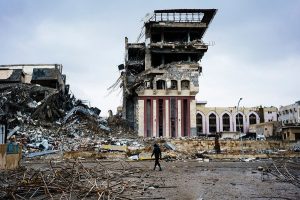 Lise Grande, UN Humanitarian Coordinator for Iraq who doubles as the Deputy Special Representative of the UN Assistance Mission for Iraq, has described the historic city of Mosul as “a tale of two cities” with reference to the level of destruction in the eastern and western parts of the city.
Lise Grande, UN Humanitarian Coordinator for Iraq who doubles as the Deputy Special Representative of the UN Assistance Mission for Iraq, has described the historic city of Mosul as “a tale of two cities” with reference to the level of destruction in the eastern and western parts of the city.
Mosul has been under the control of the Islamic State group for three years before a strong offensive by Iraqi forces backed by militia groups and the US-led coalition helped to flush them out.
Lise Grande explained that the Eastern Mosul is “recovering” from the fighting and it’s “on the mend.” Even though “conditions aren’t great”, life is slowly going back to normal as “people are home, schools are open, business are open and markets are open.”
It is a different reality in Western Mosul, which experienced most of the fighting. “In the 15 completely destroyed neighborhoods, there are 230,000 civilians who come from those districts who are not coming home anytime soon”; compared to 20,000 people of Eastern Mosul.
The influence of the Islamic State group has reduced drastically, and Grande thinks that military operation in Tal Afar, Hawija and in the Euphrates Valley in western Anbar Province would displace “several hundred more civilians.” She estimated the number of displaced people in the country to reach 3.5 million “when the military campaign in Iraq is over.”
The UN official also acknowledged the efforts of the humanitarian agencies. She commended them for their efforts stating that “very exceptionally, humanitarian agencies were not near the front line, they were on the front line.”
In another development, the Iraqi Central Bank said in a statement that the Islamic State group controlled an estimated total of around $730 million held in banks plus $101 million.
These were banks located within the areas under their control and “most of these deposits belong to the government.”
According to the Central Bank, after June 15, 2014, the militants gained control over 121 branches of state-owned and private banks in the Nineveh, Saladin, Diyala and Anbar provinces.
